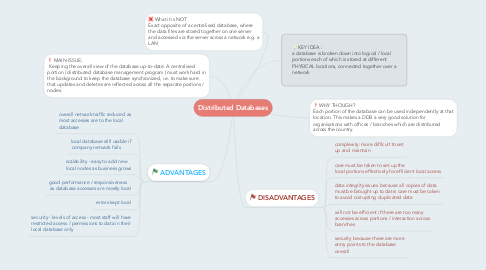Distributed Databases
by Sue Ferguson

1. ADVANTAGES
1.1. overall network traffic reduced as most accesses are to the local database
1.2. local database still usable if company network fails
1.3. scalability - easy to add new local nodes as business grows
1.4. good performance / responsiveness as database accesses are mostly local
1.5. errors kept local
1.6. security - levels of access - most staff will have restricted access / permissions to data in their local database only
2. MAIN ISSUE: Keeping the overall view of the database up-to-date. A centralised portion ( distributed database management program ) must work hard in the background to keep the database synchronized, i.e. to make sure that updates and deletes are reflected across all the separate portions / nodes.
3. What it is NOT Exact opposite of a centralised database, where the data files are stored together on one server and accessed via the server across a network e.g. a LAN
4. DISADVANTAGES
4.1. complexity: more difficult to set up and maintain
4.2. care must be taken to set up the local portions effectively for efficient local access
4.3. data integrity issues because all copies of data must be brought up to date; care must be taken to avoid corrupting duplicated data
4.4. will not be efficient if there are too many accesses across portions / interaction across branches
4.5. security because there are more entry points to the database overall
5. WHY THOUGH? Each portion of the database can be used independently at that location. This makes a DDB a very good solution for organisations with offices / branches which are distributed across the country.
6. KEY IDEA : a database is broken down into logical / local portions each of which is stored at different PHYSICAL locations, connected together over a network


